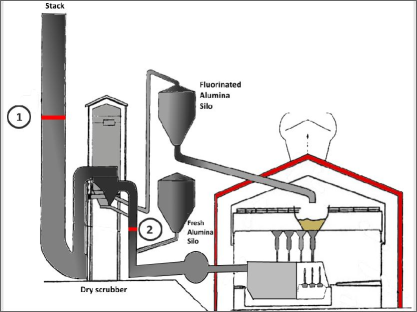
Emissions from the Aluminium smelting process contains harmful gases for the environment, one of these gases is Hydrogen Fluoride (HF).
The aluminium smelting process generates large amounts of HF gas, the majority of this gas is captured and treated in wet or dry scrubbers. NEO Monitors LaserGas TM II SP HF monitor is an excellent instrument for process and emission control, because of its low detection limit of HF gas, short response time and low maintenance requirements.
HF emission is subject to increasingly stringent national and regional regulations, due to the demand for toxic gas measurement in the environment along with the emphasis on safety.
Process
Primary Aluminium is produced by reduction of Alumina by electrol-ysis in a molten bath of Cryolite.
Aluminium Fluoride (AlF3) is one of the additives used to reduce the melting point, and the addition of AlF3 results in gaseous Hydrogen Fluoride (HF).
A dry scrubber is typically used to remove HF from the off gas by mixing it with fresh (primary) Alumina. The gaseous HF bonds to the primary Alumina and the HF enriched Alumina is gathered in a bag filter system and transported to the process to be used in the electrolysis process.
Typical Process Data
| HF Concentration |
200-400 mg/m3 (Scrubber inlet) |
|
0-1 mg/m3 (dry scrubber outlet/stack) |
|
<0-1 mg/m3 (wet scrubber outlet/stack) |
| Temperature |
100-150 C |
| Druk |
Atmospheric |
Optical Path
Length |
1-6 meter |
Documentation
 Combustion HF Stack Monitoring in Aluminium Plants
Combustion HF Stack Monitoring in Aluminium Plants